
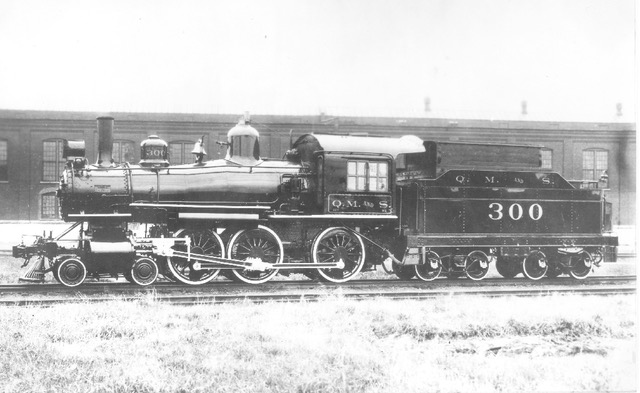
Steam locomotive 300 of the Quebec, Montreal & Southern Railway.
On March 30, 1883, United Counties Railways is incorporated by the Quebec provincial legislature. This railway company’s shareholders are mostly French-Canadian. Their aim is to connect the village of Richelieu with the town of Sorel.
After receiving government grants and obtaining, in 1888, an amendment to its charter, which now designates Iberville as the terminal for the south section of the railway instead of the Village of Richelieu, the company begins building the railway in 1892. They start from Saint-Hyacinthe and work toward Saint-Damase, Rougemont and Sainte-Angèle-de-Monnoir.
The company has a station at the Village of Rougemont and a flag stop called “Caroline” at the corner of Rang Petite-Caroline and Rang Grande-Caroline. Ownership of the company and its line will pass, in 1900, to the Quebec Southern Railway. In 1906, it is sold to the Quebec, Montreal & Southern Railway, and on July 15, 1929, the Canadian National Railway becomes the final owner. Judging this railway to be unprofitable, the CNR will terminate the line in 1931, begin removing the tracks in 1932, and eventually sell off the station buildings. Farmers will then resume possession of their former lots of land and remove any traces of this old railway, all along the line.
On September 17, 1893, the people of Rougemont gather alongside the village railway station to admire the new train and meet the dignitaries in attendance for its inaugural run. Canon Charles-Philippe Choquette briefly describes the excursion by rail: “Holding their complimentary tickets, 250 people, of whom 150 were from Saint-Hyacinthe, made the trip and returned at 6 p.m. The tracks were superb and the passengers were amazed at how smooth the ride was, compared to most other railways.”
Between 1850 and 1930, the arrival of the railway in a rural community remains a very popular event. It is regarded as being synonymous with progress and a catalyst for the economic development of the village or small town. Agriculture will also take advantage of this method of transport: farmers will devise new production techniques since they now have rapid access to new markets in the cities. At the same time, the train will facilitate the exile of hundreds of thousands of French-Canadians from rural areas like this to the states of New England. They go in search of regular factory work, particularly in the American spinning mills.
This second station in the Village of Rougemont, located opposite Rang Double (now Rue Principale), has the typical architecture of rural stations in southern Quebec in this era. It is a rectangular wooden structure with a four-slope roof. In the photograph below, from 1910, we see the two types of luggage cart that were standard equipment at the old railway stations. In addition to the ticket office, there are signs indicating the services available at the station. Dominion Express Co. will transport goods or money orders across Canada and to the United States and Europe. The Great North Western Telegraph Co. will telegraph your message anywhere in North America. The station master has all the related skills, such as receiving goods and operating the telegraph machine. The use of this means of communication will disappear in favour of telex, fax, telephone and, lastly, electronic messaging. By 1929, the telegraph service will reach a peak of usage in the United States, with more than 200 million messages sent.
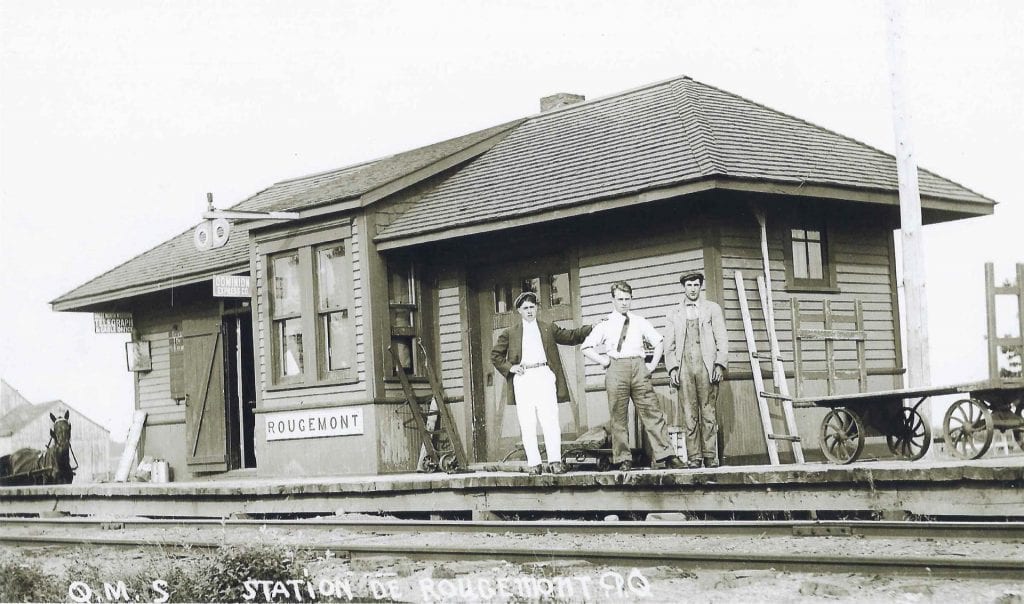
Station of the Quebec, Montreal & Southern Railway, Village of Rougemont, circa 1910.
From the very start of operations on this train line by the United Counties Railways, there is a flag stop here called “Caroline”. This railway halt consists of a small platform and shelter alongside the tracks. The stop is used by people from the adjacent farms of Rougemont and Saint-Damase. It helps them transport farm products to markets in the city and deliver forage crops to New England.
The majority of the stations built in rural areas are small wooden structures painted in different colours. They have no bedrock foundation and in most cases are simply heated by a coal or wood stove. They are usually rectangular and measure 20 feet by 50 feet. In 1920, there are 273 stations in 23 counties in southern Quebec, or one station for every area of 29.5 square miles. This reveals to us that the rural counties of this era had a great quantity of railway tracks.
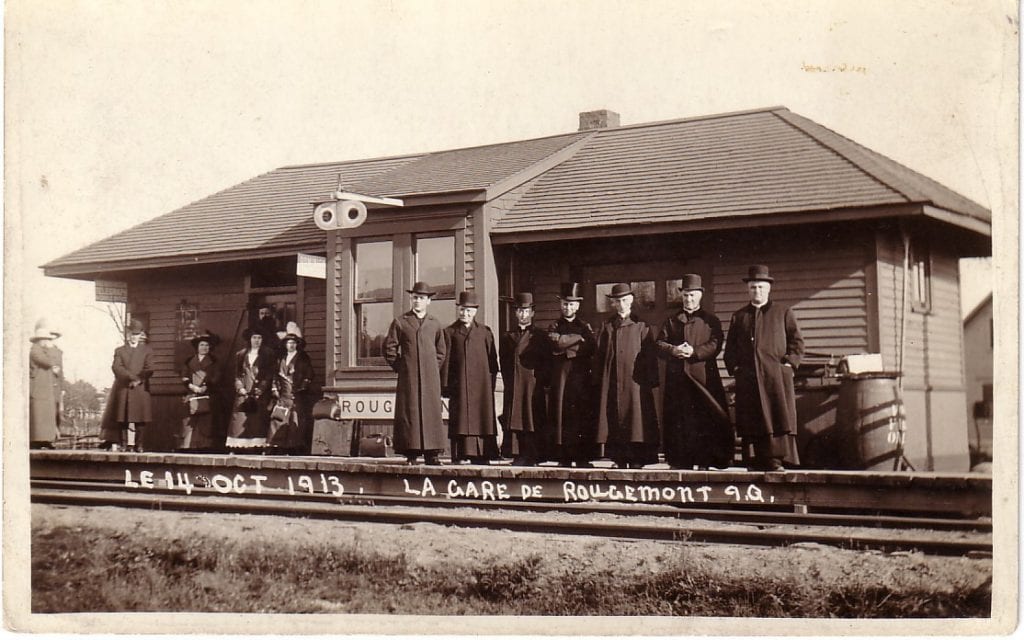
Clergymen await the arrival of their train at the Quebec, Montreal & Southern Railway station in Rougemont, October 14, 1913.
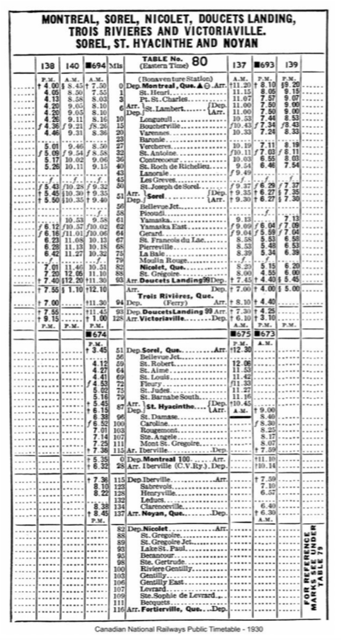
We can see the Rougemont and Caroline stations on this Canadian National Railway schedule sheet from 1930.
The dimensions and divisions of a typical rural station in southern Quebec in the first quarter of the 20th century
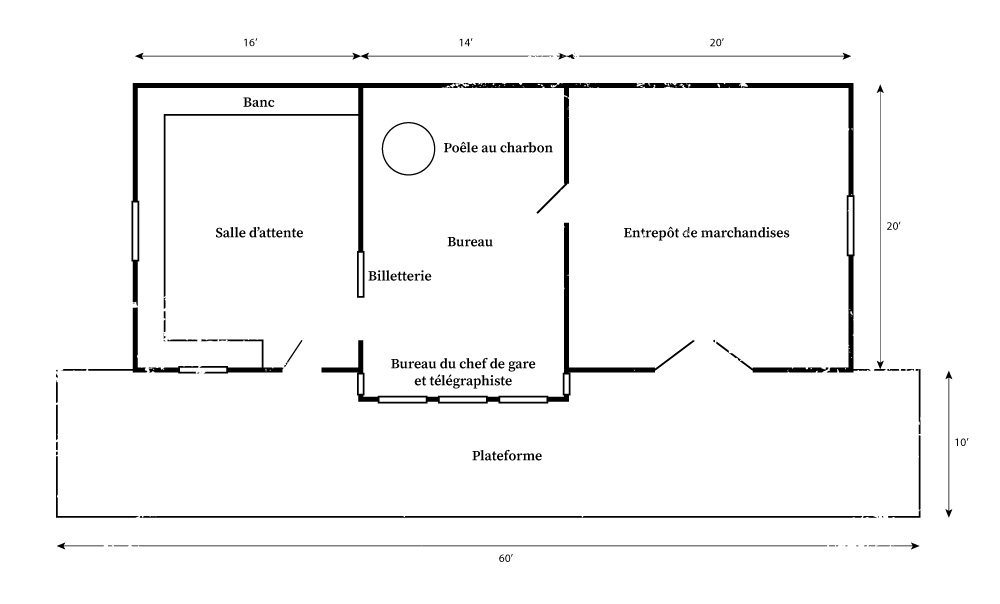
Location of the pannel on La Route des Champs



Research and text
Gilles Bachand, historian
Société d'histoire et de généalogie des Quatres Lieux
References and photographs (2020)
Archives of the Société d’histoire et de généalogie des Quatre Lieux
Archives of the Société d’histoire de la Seigneurie de Monnoir